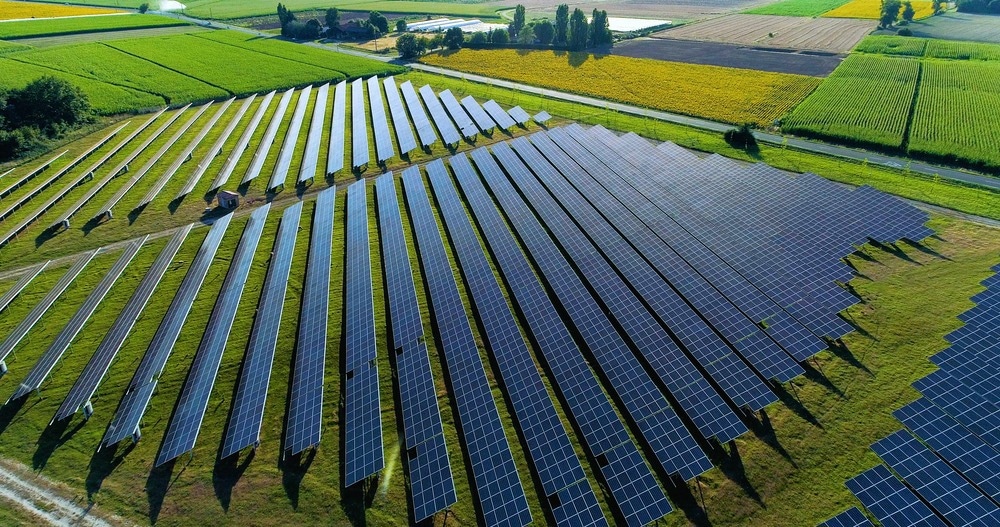In a paper recently published in the journal ACS Energy Letters, researchers comprehensively studied phase manipulation efficiency in BA2MA4Pb5 I16 (n = 5) quasi-two-dimensional (quasi-2D) perovskites. They used the dimethyl sulfoxide (DMSO) solvent to manipulate the crystalline growth process in the quasi-2D perovskite film.

Study: Band Alignment Boosts over 17% Efficiency Quasi-2D Perovskite Solar Cells via Bottom-Side Phase Manipulation. Image Credit: Fly_and_Dive/Shutterstock.com
Background
Recently, organic-inorganic hybrid perovskites (OIHPs) have received significant interest. Conventional three-dimensional (3D) perovskite solar cells (PSCs) can currently reach a power conversion efficiency (PCE) of 25.7%. The hurdle on the route to commercialization, however, is the issue of stability, due to the sensitivity of 3D perovskites to moisture and oxygen. Ruddlesden-Popper (RP) quasi-2D perovskites with hydrophobic and stable organic ligands have lately emerged as viable options for breaking these limitations.
About the Study
The team used a customized hot-cast technique, i.e., a constant thermal-annealing spin-coating (CTAS) procedure, to eliminate the low-n-value (n 2) phases at the lower end of a pin quasi-2D PCS using a DMSO solvent. In this method, the substrate was heated and maintained at a steady temperature while being spin-coated in the CTAS process, resulting in a stable thermal environment.
In the CTAS technique, an extra heater was built inside the spin coater's chuck, allowing the temperature to be maintained during the spin-coating operation. This approach offered more reproducible and stable spin-coating conditions, ensuring film reproducibility and quality as well as a broader fabrication window. Furthermore, the spin temperature was tuned during the CTAS process. Methylammonium chloride (MACl) in trace amounts was introduced to the precursors based on the optimal DMSO 0.25 ratio to facilitate the crystallization of the film.
To thoroughly study the influence of DMSO on film shape, phase distribution, and crystal growth direction during the CTAS process, various amounts of DMSO were introduced to the DMF-based precursors. Furthermore, the external quantum efficiencies (EQEs) of the solar cells were analyzed to further investigate the cause of the elevated short circuit current density (Jsc) value under various conditions. Additionally, the EQEs with films under different MACl doping amounts were measured.
X-ray diffraction (XRD) and field-emission scanning electron microscopy (SEM) pictures were used to evaluate the overall shape and crystallization of the films. To acquire a better understanding of the crystal orientations, the grazing incidence of wide-angle X-ray scattering (GIWAXS) on both sides of the DMSO 0.25 and DMSO 0 films was measured. To investigate the situation on the bottom side further, the quasi-2D perovskite films from the substrates were exfoliated and the GIWAXS was measured on the exposed side. Femtosecond transient absorption (TA) was used on the films to offer a detailed examination of the phase distribution at the bottom side.
Observations
After optimization, the film had a more consistent vertical crystalline orientation. Meanwhile, accurate band alignment was obtained, and energy loss owing to mismatch in the interfacial energy band was greatly decreased in our quasi-2D PSCs, yielding a Jsc value of 19.21 mA/cm2. Furthermore, the PSCs' stability was sufficient. The device operated at the point of full power for over 1000 seconds without a current dip and retained 96.7% of its baseline PCE after 1000 hours in the nitrogen glovebox without encapsulation.
As the DMSO ratio rose, the average Jsc increased considerably, with DMSO 0 with 9.74 mA/cm2 and DMSO 0.25 with 18.94 mA/cm2. The substantial improvement in short-circuit current was accounted for by enhanced carrier mobility in the bulk perovskite layer and more effective interfacial carrier extraction. The final optimized device, which used DMSO 0.25 and a modest quantity of MACl, achieved a 17.66% PCE and a Voc value of 1.22 V.
These findings revealed that DMSO effectively controlled crystalline growth orientations while improving the overall crystalline quality of the film. This demonstrated that the presence of low-n-value phases existing at the bottom side, as well as the use of DMSO in the CTAS technique, may successfully modify the phases at the bottom.
The DMSO 0 film demonstrated very intense photoluminescence associated with the n = 2 phase at the bottom, whereas the DMSO 0.25 film detected no signal in this range. The results indicated that the low-n components existing at the bottom were eliminated successfully using the CTAS crystallization procedure that employed DMSO.
The DMSO-assisted CTAS approach reduced the low-n value phase, which was replaced by the n = 3 phase at the bottom. Along with the slight alteration of the bottom-side phase alignment as well as quasi-2D perovskite crystal growth orientation, charged recombination was reduced further through film quality improvement via MACl doping. The device showed 96.7% of its baseline efficiency and 97% of its initial PCE, compared to 25% for 3D perovskites.
Conclusions
To summarize, high-performance quasi-2D PSCs were created in the perovskite layer using practical phase manipulation along with vertical preferred crystal orientation. The film achieved a precisely vertical orientation in addition to a good phase distribution. The device achieved a PCE of 17.66% with an open voltage of 1.22 V after using MACl to increase the crystalline quality of the films. Finally, this study demonstrated an efficient and simple way of manipulating the phase distribution in a quasi-2D perovskite.
More from AZoM: The Use of AI in Chemical Processes
Disclaimer: The views expressed here are those of the author expressed in their private capacity and do not necessarily represent the views of AZoM.com Limited T/A AZoNetwork the owner and operator of this website. This disclaimer forms part of the Terms and conditions of use of this website.
Source:
Haoliang Wang., et al. Band Alignment Boosts over 17% Efficiency Quasi-2D Perovskite Solar Cells via Bottom-Side Phase Manipulation, ACS Energy Letters 0, 7 DOI: https://pubs.acs.org/doi/10.1021/acsenergylett.2c01453